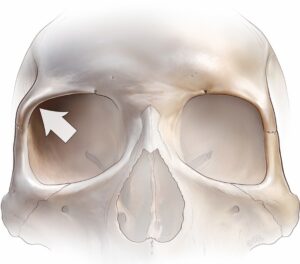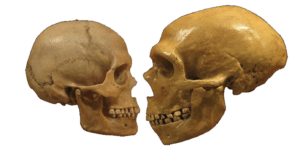The Supraorbital Ridge
The supraorbital ridge, commonly known as the brow ridge, is more than just an anatomical feature above our eyes. This prominent bone structure has played a crucial role in human evolution and continues to influence how we communicate and interact with others today. From its varied manifestations across human species to its modern implications for facial expression and social interaction, the supraorbital ridge offers fascinating insights into our past and present.
The Anatomy and Function of the Supraorbital Ridge
The supraorbital ridge is a bony projection located above the eye sockets (orbits) in primates and other mammals. In humans, it forms part of the frontal bone and serves several important functions. According to Dr. Melanie Chang’s research at Portland State University, the ridge primarily evolved to provide structural support for the frontal bone and protect the eyes from impact.

However, recent studies suggest that the supraorbital ridge’s role extends beyond mere mechanical support. Dr. Todd Rae of the University of Roehampton has proposed that the ridge also plays a crucial role in distributing mechanical stress during mastication (chewing). This theory, known as the “masticatory-force hypothesis,” suggests that larger brow ridges helped our ancestors process tough foods by absorbing and distributing the forces generated during chewing.
Neanderthals vs. Homo Sapiens: A Tale of Two Brow Ridges
One of the most striking differences between Neanderthals and modern humans lies in their supraorbital ridge morphology. Neanderthals possessed dramatically pronounced brow ridges, which created a distinctive profile that set them apart from Homo sapiens. Neanderthal brow ridges were not only larger but also more continuous across the face, forming what anthropologists call a “supraorbital torus.”
In contrast, modern humans developed a flatter, more vertical forehead with reduced brow ridges. This evolutionary change had significant implications for facial mobility and expression. The reduced brow ridge in Homo sapiens allowed for greater movement of the forehead muscles and eyebrows, facilitating more nuanced facial expressions.

The Communication Advantage: How Flatter Brows Enhanced Social Interaction
The reduction in supraorbital ridge size among Homo sapiens may have provided a significant advantage in social communication. Research by Dr. Penny Spikins from the University of York suggests that the ability to form more subtle and varied facial expressions played a crucial role in the development of complex social relationships and cooperative behaviors.
The flatter brow region of modern humans enables a wider range of eyebrow movements, which has been shown to convey various emotional states and social signals:
- Trust and approachability: Raised eyebrows can signal openness and friendliness
- Emotional states: Furrowed brows can communicate confusion, concern, or concentration
- Social bonding: Synchronized eyebrow movements during conversation can enhance rapport
- Non-verbal communication: Quick eyebrow flashes serve as greeting signals across cultures
Modern Variation and Clinical Implications
While modern humans generally have flatter supraorbital ridges compared to our ancestors, there is still considerable variation among individuals today. Approximately 10-15% of modern humans possess more pronounced brow ridges, with the feature being more common in males due to hormonal influences during development.
For individuals with pronounced supraorbital ridges who wish to modify their appearance, modern surgical techniques offer solutions. Brow bone reduction surgery, also known as forehead contouring or orbital rim reduction, can help soften facial features and create a more harmonious profile. Reducing prominent brow ridges can significantly impact social interaction and self-perception.

The Evolutionary Puzzle: Why Did Brow Ridges Reduce?
The question of why humans evolved smaller supraorbital ridges continues to intrigue anthropologists. Several theories have been proposed:
The Social Communication Theory
Dr. Ricardo Godinho and colleagues at the University of York have suggested that the reduction in brow ridge size was primarily driven by the advantages it provided in social communication. Their 2018 study in Nature Ecology & Evolution demonstrated that large brow ridges were not mechanically necessary for skull structure, suggesting that their reduction may have been influenced by social factors.
The Facial Reduction Theory
Another perspective, championed by Dr. Daniel Lieberman of Harvard University, suggests that the reduction in brow ridge size was part of a broader trend toward facial reduction in human evolution. This process, known as craniofacial feminization, may have been linked to decreased levels of hormones like testosterone and changes in diet.
The Climate Adaptation Theory
Some researchers, including Dr. Katarina Harvati from the University of Tübingen, propose that changes in brow ridge size may have been influenced by climate adaptation. Smaller brow ridges could have helped regulate temperature in the face and brain as humans moved into different environmental zones.
Implications for Modern Human Behavior
Understanding the evolution and function of the supraorbital ridge has important implications for modern human behavior and social interaction. Research suggests that humans are unconsciously attuned to subtle variations in brow ridge morphology when making social judgments.
Studies have shown that brow ridge size can influence:
- First impressions and perceived personality traits
- Assessments of dominance and aggression
- Perceptions of gender and age
- Social attractiveness and approachability
Future Research Directions
Current research continues to explore the relationship between supraorbital ridge morphology and human behavior. Emerging areas of study include:
- The role of brow ridge variation in cross-cultural communication
- The influence of facial structure on virtual communication and emoji design
- The relationship between brow ridge morphology and facial recognition technology
- The impact of surgical modification on social interaction and personal identity
Conclusion
The supraorbital ridge stands as a fascinating example of how anatomical features can influence social behavior and communication. From its robust presence in our evolutionary ancestors to its reduced form in modern humans, this structure continues to play a role in how we interact and express ourselves. As we continue to study this feature, we gain deeper insights into human evolution, social communication, and the complex interplay between anatomy and behavior.
Understanding the significance of the supraorbital ridge not only helps us appreciate our evolutionary heritage but also informs us of why brow bone reduction surgery is beneficial in social interactions and aesthetics.
If you are thinking about brow bone reduction surgery, Schedule a consultation with Dr. Sarah Saxon, facial plastic surgeon and expert in this life-changing procedure.
You May Also Like: